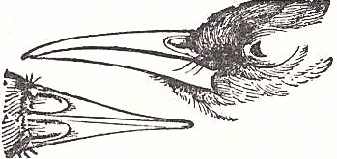Dabchick


Picture of Dacnis head and beak |
Dacnis
A genus established by Cuvier, being now part
of the Thraupidae family of tanagers and their relatives. Ninespecies
are recognized, and the skins of two or three of them, remarkable for their
beautiful blue or bluish-green coloration, are among the commonest of those
in South America. The Blue Dacnis has a particularly striking conspicuous
blue and black colouring
|
Daker Hen
An old and widely-spread name of the Land-RAIL, referring, it is thought,
to the unsteady flight of the bird, for to "dacker" (Frisian,
dakkern,
M.
Dutch, daeckeren), signifying to stagger, totter or hesitate, is
a well-known word in Lincolnshire and perhaps in other districts (cf.
Cordeaux,
Zoologist,
1883,
pp. 228, 229).
Darr
A local name applied to some species of TERN.
Darter
See SNAKE-BIRD.
Dassie-Vanger
or Coney-catcher
The Dutch name for an EAGLE in South Africa, adopted by English residents
- the "Dassie" being the Rock Hyrax, also known as the Cape Hyrax or Rock
Rabbit (Procavia capensis).
Daw
See Jackdaw.
Dayal
or Oriental Magpie Robin

Demoiselle
Crane

Dentirostres
A group of Birds discriminated by Dumeril in 1806 (Zool. Analyt. p.
41), composed of the genera (as then regarded) Buceros
(HORNBILL),
Momotus
(MOTMOT),
and Phytotoma (PLANT-CUTTER), as having their bills scored with
at least three notches (dentelures). However, the term Dentirostres
was used in 1817 in a wholly different sense by Cuvier (Regn. Animal,
page
336), so as to contain:
-
Laniidae
-
Tanagridae
-
Muscicapidae
-
Ampelidae
[ =
Cotingidae]
-
Edolius
-
Turdidae
-
Pyrrhocorax
-
Oriolidae
-
Myiothera
-
Cinclus
-
Philedon
-
Gracula
-
Menura
-
Pipra
-
and Motacilla.
Subsequently the term was adopted for a while with
more or less some modification by a great number of systematists of the
time.
|





